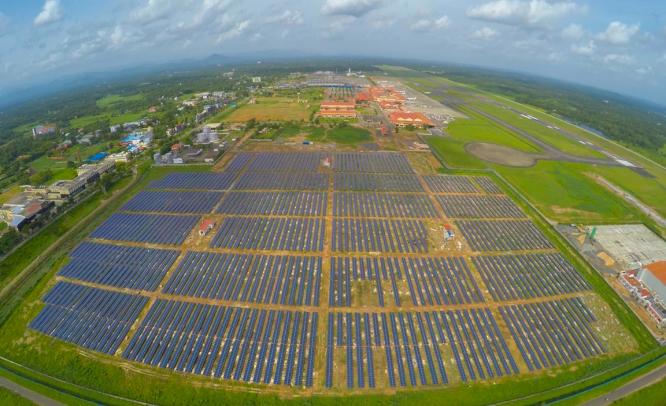World’s first solar powered airport has more electricity than it needs
Suparna Goswami Bhattacharya
May 10, 2016: As the plane hovers over Cochin airport in India, you will be astonished to see a large number of solar panels in the vast compound. There are more than 46,000 of the reflective panels tapping the rays from the bright sun and converting them into energy.
The commercial hub of Kerala has the world’s first fully functional solar-powered airport. This is no mean feat considering that countries like Germany, US and China, which are far ahead of India in terms of solar expertise, are yet to have an airport powered by the Sun.
“Purely economic factors rather than a green initiative pushed us into going for a solar powered-airport. We basically wanted to bring down our electricity expenses,” says Jose Thomas P, General Manager, Cochin International Airport.
The airport handles more than 1,000 flights every week. It is the seventh busiest in India.
Before installation of solar panels, the annual expense on power stood at about $1.8 million. It was the airport’s second biggest expenditure after employee cost. “At that time, the local electricity board was charging a tariff of Rs 7 (about 10 cents) per KWH, which we felt was high. This prompted us to explore alternatives,” Thomas says.
After much research and numerous meeting, the authorities zeroed in on solar energy. By the end of 2012, officials decided to set up a pilot plant with a capacity of 100KW, which had the potential to generate approximately 400 units of electricity every day.
“The plant was commissioned in March 2013. In the same year, around November we expanded capacity by 1MW by putting 4,000 solar panels on the roof of the aircraft maintenance building,” he says.
The performance of both the plants was monitored for more than a year. Their success gave officials the confidence to go for a bigger project.
The plant capacity was chosen as 12MW, which could produce 52,000 units every day against the requirement of 50,000 units.
Cochin airport called for a global tender in January 2015 in which 18 companies participated. Bosch emerged the lowest bidder with a total project cost of approximately $9.25 million. Bosch started work in March 2015 and installed 46,000 solar panels on 45 acres within 5 ½ months. The plant was commissioned on August 18, 2015.
“This land had been earmarked for future expansion of the cargo terminal but had been lying vacant for 16 years. The plant has been set up after leaving enough space for expansion of the cargo terminal, which is expected to take place in the next 10-15 years,” says Thomas.
“It seems like a dream. Today, we produce more energy than we need. We bank on the state grid only when required… say on rainy days.”
Salient points
- Average daily electricity requirement at Cochin airport is 50,000 units
- Excess power is exported to the State Electricity Board’s grid
- At night, airport can draw equivalent of power given to the grid during the day
- The payback period of the solar power plant is six years

